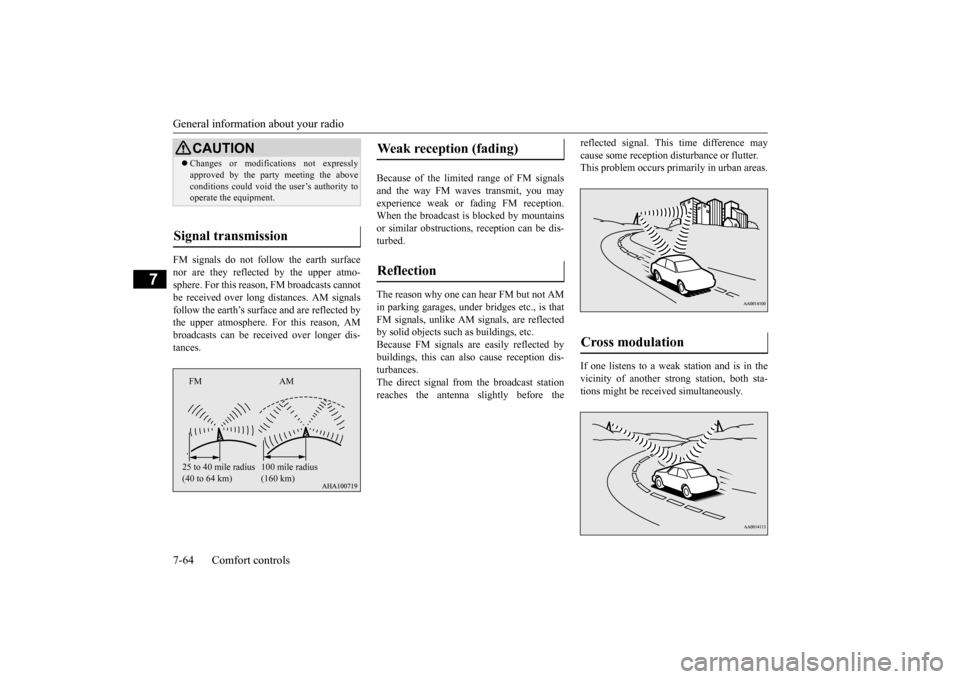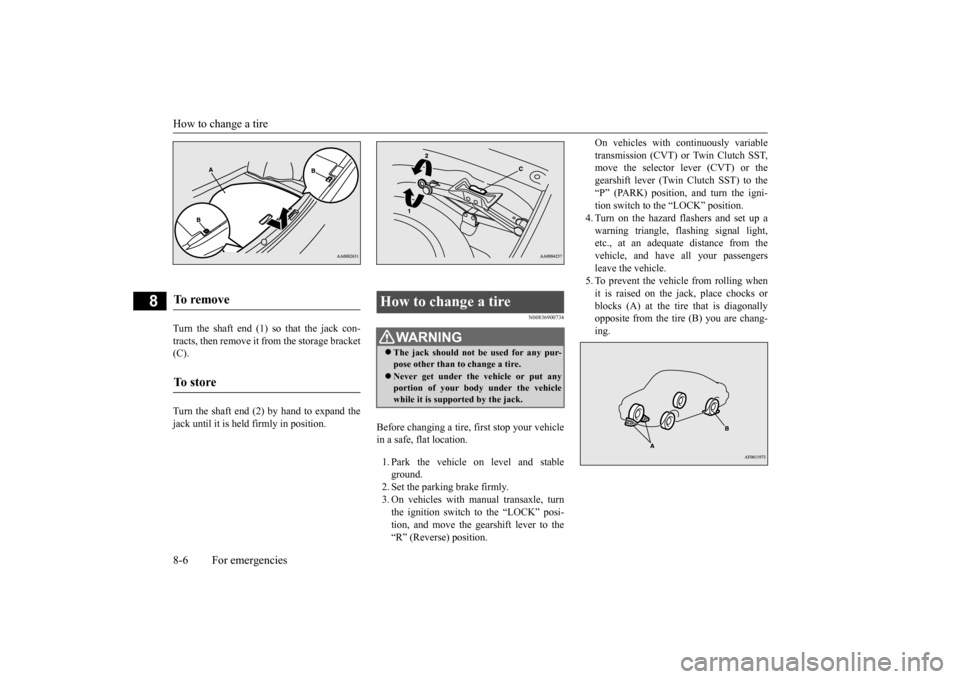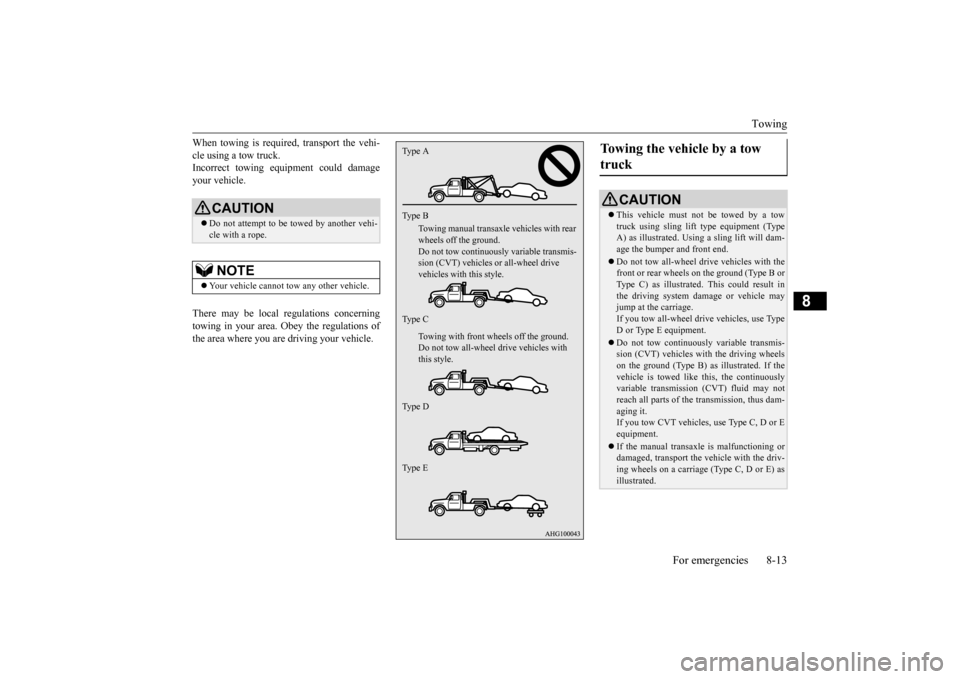2015 MITSUBISHI LANCER transmission
[x] Cancel search: transmissionPage 339 of 434

General information about your radio 7-64 Comfort controls
7
FM signals do not follow the earth surface nor are they reflected by the upper atmo- sphere. For this reason, FM broadcasts cannot be received over long distances. AM signalsfollow the earth’s surface and are reflected by the upper atmosphere. For this reason, AM broadcasts can be received over longer dis-tances.
Because of the limited
range of FM signals
and the way FM waves transmit, you mayexperience weak or fading FM reception. When the broadcast is blocked by mountains or similar obstructions, reception can be dis-turbed. The reason why one can hear FM but not AM in parking garages, under bridges etc., is that FM signals, unlike AM signals, are reflectedby solid objects such as buildings, etc. Because FM signals are easily reflected by buildings, this can also cause reception dis-turbances. The direct signal from the broadcast station reaches the antenna slightly before the
reflected signal. This time difference may cause some reception disturbance or flutter. This problem occurs primarily in urban areas. If one listens to a weak station and is in the vicinity of another strong station, both sta-tions might be received simultaneously.
CAUTION Changes or modifications not expressly approved by the party meeting the above conditions could void the user’s authority to operate the equipment.
Signal transmission
FM AM 25 to 40 mile radius (40 to 64 km)
100 mile radius (160 km)
Weak reception (fading) Reflection
Cross modulation
BK0210300US.bo
ok 64 ページ 2014年4月8日 火曜日 午前10時46分
Page 343 of 434

If the vehicle breaks down 8-2 For emergencies
8
N00836300161
If your vehicle breaks down on the road, move to the shoulder and turn on the hazardwarning flashers. If there is no shoulder, or the shoulder is not safe, drive in the right lane slowly, with the hazard lights flashing, untilyou come to a safe stopping place. Keep the flashers flashing. If the engine stops, there will be no power assist to the steering and brakes, making these difficult to use. The brake booster will not work, so the brakes will not grip well. The brake pedalwill be harder to press than usual. Since there is no power steering assist, the steering wheel will be hard to turn.
Get help from your passengers, bystanders, etc. to push the vehicl
e and move it to a safe
zone.
N00836400713
If the engine cannot be started because the battery is weak or dead, you can start it withthe battery from another vehicle using jumper cables. 1. Take off any metal jewelry such as watch bands or bracelets that might make an accidental electrical contact. 2. Position the vehicles close enough together so that the jumper cables can reach, but be sure the vehicles aren’ttouching each other.
3. You could be injured if the vehicles move. Set the parking brake firmly on each vehi-cle. Put an automatic transaxle, CVT or Twin Clutch SST in “P” (PARK) or a manual transaxle in “N” (Neutral). Turnthe ignition key to the “LOCK” position. 4. Make sure your battery electrolyte is at the proper level. (Refer to “Checking bat- tery electrolyte level” on page 9-15.)
If the vehicle breaks down If the engine stops/fails When the engine fails at the intersection
Jump-starting the engine
WA R N I N G When using jumper cables to start a vehi- cle, follow the procedures and be very cau- tious. CAUTION Do not try to start your vehicle by pushing or towing. Vehicles with continuously variable transmission (CVT) or Twin Clutch SST cannot be started this way. Pushing or towinga vehicle that has a manual transaxle may overheat and damage the catalytic converter. Also, there is more ri
sk of an accident when
a vehicle is being pushed or towed.
CAUTION Check the other vehicle. It must have a 12- volt battery. If the other system isn’t 12-volt, both systems can be damaged.WA R N I N G Turn the ignition key to the “LOCK” posi- tion on both vehicles. Make sure that thecables or your clothes cannot be caught by the fan or drive belt. Personal injury could result. NOTE
Turn off all lights, heater, and other electrical loads. This will avoid sparks and help save both batteries.
BK0210300US.bo
ok 2 ページ 2014年4月8日 火曜日 午前10時46分
Page 347 of 434

How to change a tire 8-6 For emergencies
8
Turn the shaft end (1) so that the jack con- tracts, then remove it from the storage bracket (C). Turn the shaft end (2) by hand to expand the jack until it is held firmly in position.
N00836900734
Before changing a tire, first stop your vehicle in a safe, flat location. 1. Park the vehicle on level and stable ground.2. Set the parking brake firmly. 3. On vehicles with manual transaxle, turn the ignition switch to the “LOCK” posi-tion, and move the gearshift lever to the “R” (Reverse) position.
On vehicles with continuously variable transmission (CVT) or Twin Clutch SST, move the selector lever (CVT) or the gearshift lever (Twin Clutch SST) to the“P” (PARK) position, and turn the igni- tion switch to the “LOCK” position. 4. Turn on the hazard flashers and set up awarning triangle, flashing signal light, etc., at an adequate distance from the vehicle, and have all your passengersleave the vehicle.5. To prevent the vehicle from rolling when it is raised on the jack, place chocks or blocks (A) at the tire that is diagonallyopposite from the tire (B) you are chang- ing.
To remove To s t o r e
How to change a tire
WA R N I N G The jack should not be used for any pur- pose other than to change a tire. Never get under the vehicle or put any portion of your body under the vehiclewhile it is supported by the jack.
BK0210300US.bo
ok 6 ページ 2014年4月8日 火曜日 午前10時46分
Page 354 of 434

Towing
For emergencies 8-13
8
When towing is required, transport the vehi- cle using a tow truck. Incorrect towing equipment could damage your vehicle. There may be local regulations concerning towing in your area. Obey the regulations of the area where you are driving your vehicle.
CAUTION Do not attempt to be towed by another vehi- cle with a rope.NOTE
Your vehicle cannot tow any other vehicle.
Type A Type B
Towing manual transaxle
vehicles with rear
wheels off the ground. Do not tow continuously
variable transmis-
sion (CVT) vehicles or all-wheel drive vehicles with this style.
Type C
Towing with front wheels off the ground. Do not tow all-wheel drive vehicles with this style.
Type D Type E
Towing the vehicle by a tow truck
CAUTION This vehicle must not be towed by a tow truck using sling lift type equipment (TypeA) as illustrated. Using a sling lift will dam- age the bumper and front end. Do not tow all-wheel dr
ive vehicles with the
front or rear wheels on the ground (Type B or Type C) as illustrated. This could result inthe driving system damage or vehicle may jump at the carriage. If you tow all-wheel drive vehicles, use TypeD or Type E equipment. Do not tow continuously variable transmis- sion (CVT) vehicles with the driving wheels on the ground (Type B) as illustrated. If the vehicle is towed like this, the continuouslyvariable transmission (CVT) fluid may not reach all parts of the transmission, thus dam- aging it.If you tow CVT vehicles, use Type C, D or E equipment. If the manual transaxle is malfunctioning or damaged, transport the vehicle with the driv- ing wheels on a carriage (Type C, D or E) as illustrated.
BK0210300US.bo
ok 13 ページ 2014年4月8日 火曜日 午前10時46分
Page 358 of 434

9
Vehicle care and maintenanceService precautions .........
.................................................................9-2
Catalytic converter
.................................................
..........................9-2
Engine hood ..............................
.......................................................9-3
View of the engine comp
artment .....................................................9-5
Engine oil and oil filt
er ................................
....................................9-6
Engine coolant ................
.................................................................9-8
Air cleaner filter ....
.................................................
..........................9-9
Manual transaxle oil (if so
equipped) ............................................. 9-11
Continuously variable transmission (CVT) fluid (if so equipped) .
.................................................
........................ 9-11
Twin Clutch Sportronic shift transmission (Twin Clutch SST) fluid (if so equipped
)..........................................
........................9-12
Transfer oil (All-wheel dr
ive models) ...........................................9-12
Rear axle oil (All-wheel dr
ive models) ........................................9-12
AWC control fluid (if so
equipped) ................................................9-12
Washer fluid ....................
...............................................................9-13
Brake fluid/Clutch fluid (if
so equipped)........................................9-13
Power steering fluid (if so equipped)..............................................9-14 Battery .......................................
.....................................................9-14
Tires ..........................................
.....................................................9-17
Clutch pedal free play (if so equipped)...........................................9-24 Brake pedal free play
.............................................
........................9-25
Parking brake lever stroke .............................................................9-25Parking brake break-in
...........................................
........................9-25
Wiper blades ...................
...............................................................9-25
Emission-control system maintenance ..........................................9-25General maintenance
.............................................
........................9-27
For cold and snowy weat
her ..........................................................9-28
Fusible links ...................
.................................................
............... 9-28
Fuses ..................................................
............................................ 9-29
Replacement of light bul
bs ...................................
......................... 9-34
Vehicle care precautions
.......................................
......................... 9-48
Cleaning the inside of you
r vehicle ............................................... 9-48
Cleaning the outside of your
vehicle ............................................. 9-49
BK0210300US.bo
ok 1 ページ 2014年4月8日 火曜日 午前10時46分
Page 368 of 434

Manual transaxle oil (if so equipped) Vehicle care and maintenance 9-11
9
5. Install the air cleaner filter and put the cover back on in its original position.
6. Put the duct back on in its original posi- tion.
N00938200165
Whenever the manual transaxle oil level is checked, add oil to maintain the proper level, if necessary. Refill or change the oil according to the table.
N00938101116
The continuously variable transmission(CVT) should be maintained and serviced by an authorized Mitsubishi Motors dealer or a repair facility of your choice to obtain thebest performance and longest life. It is impor- tant that the transmission fluid is kept at the correct level.
NOTE
Genuine Mitsubishi Moto
rs Parts are recom-
mended when replacing the air cleaner filter. After replacing the air cleaner filter, make sure that the hinges at the bottom of cover are firmly set. Type 2
Except for vehicles with turbocharger
On vehicles with Type 2, after replacing the air cleaner filter, make sure that harness is firmly set so that the air cleaner hook (E) and the marking tape (F) on the harness arelocated as shown in the illustration. Except for vehicles with turbocharger, make sure that the connector is properly recon- nected.NOTE
Vehicles with turbocharger
Manual transaxle oil
(if so
equipped)Oil type
Lubricant
Mitsubishi Motors Genuine NEW MULTI GEAR OIL API
Classification GL-3
Viscosity range
SAE 75W-80
Continuously variable transmission (CVT) fluid
(if
so equipped)
BK0210300US.bo
ok 11 ページ 2014年4月8日 火曜日 午前10時46分
Page 369 of 434

Twin Clutch Sportronic shift transmission
(Twin Clutch SST) fluid (if so equipped)
9-12 Vehicle care and maintenance
9
Use only “Mitsubishi Motors Genuine CVTF-J4” transmission fluid to ensure opti-mum transmission performance. Mitsubishi Motors Corporation does not rec- ommend the addition of any fluid additives to the transmission.
N00938300036
The Twin Clutch Sportronic shift transmis-sion (Twin Clutch SST) should be maintained and serviced by an authorized Mitsubishi Motors dealer or a repair facility of yourchoice to obtain the best performance and longest life. It is impor
tant that the transmis-
sion fluid is kept at the correct level.
Use only Mitsubishi Motors Genuine SSTF-I to ensure optimum transmission performance. Mitsubishi Motors Corporation does not rec- ommend the addition of any fluid additives to the transmission.
N00938400239
Whenever the transfer oil level is checked,add oil as necessary to maintain the proper level. Fill or change the oil according to thetable.
N00915200227
Whenever the oil level is checked, add oil asnecessary to maintain the proper level.Fill or change oil according to the table.
N00915300026
Remove the lid on the trunk room right sidetrim.Check the fluid level in the reservoir 90 min- utes or more after turning the ignition switch to the “LOCK” position.Check to make certain that the AWC control fluid level is always between the “MAX” and “MIN” level markings on the fluid reservoirand refill the fluid, if necessary.
Fluid type
CAUTION Using the improper transmission fluid may damage the transaxle.
Special additives
Twin Clutch Sportronic shift transmission (Twin Clutch SST) fluid
(if so equipped)
Fluid type
CAUTION Using the improper transmission fluid may damage the transaxle.
Special additives
Transfer oil (All-wheel drive models) Oil type Lubri- cant
Mitsubishi Motors Genuine LSD
gear oil or equivalent
Rear axle oil (All-wheel drive models) Oil type Lubri- cant
Mitsubishi Motors Genuine LSD
gear oil or equivalent
AWC control fluid
(if so
equipped)To check the fluid level
BK0210300US.bo
ok 12 ページ 2014年4月8日 火曜日 午前10時46分
Page 423 of 434

Refill capacities 11-6 Specifications
11
PCD: Pitch Circle Diameter (installation holes)
N01148002101
NOTE
Contact an authorized Mitsubishi Motors dealer for details on the combination used on your vehicle.
These tires satisfy vehicle loading conditions described in this owner’s manual.NOTE
Refill capacities
Item
Capacity
Lubricants
Fuel (approxi- mate)
Front-wheel drive vehicles 15.5 gal (59.0 L)
Refer to “Fuel selection” on page 3-2.
All-wheel drive vehicles 14.5 gal (55.0 L)
Engine oil
2.0 liter
Except for vehi- cles with turbo- charger
Oil pan 4.2 qt (4.0 L)
Engine oils displaying the ILSAC certification mark (“starbust” symbol) on the container.If these oils are not available, an API classification SN or higher can be used.
Oil filter .32 qt (0.3 L)
Vehicles with turbocharger
Oil pan 5.1 qt (4.8 L)Oil filter .32 qt (0.3 L)
2.4 liter
Oil pan 4.5 qt (4.3 L)Oil filter .32 qt (0.3 L)
Power steering As required Mitsubishi Motors Genuine Power Steering Fluid Manual transaxle 2.6 qt (2.5 L)
Mitsubishi Motors Genuine NEW MULTI GEAR OIL API classification GL-3 SAE 75W-80
Continuously variable transmission (CVT) 7.5 qt (7.1 L)
Refer to “Continuously variable transmission (CVT) fluid” on page 9-11.
BK0210300US.bo
ok 6 ページ 2014年4月8日 火曜日 午前10時46分